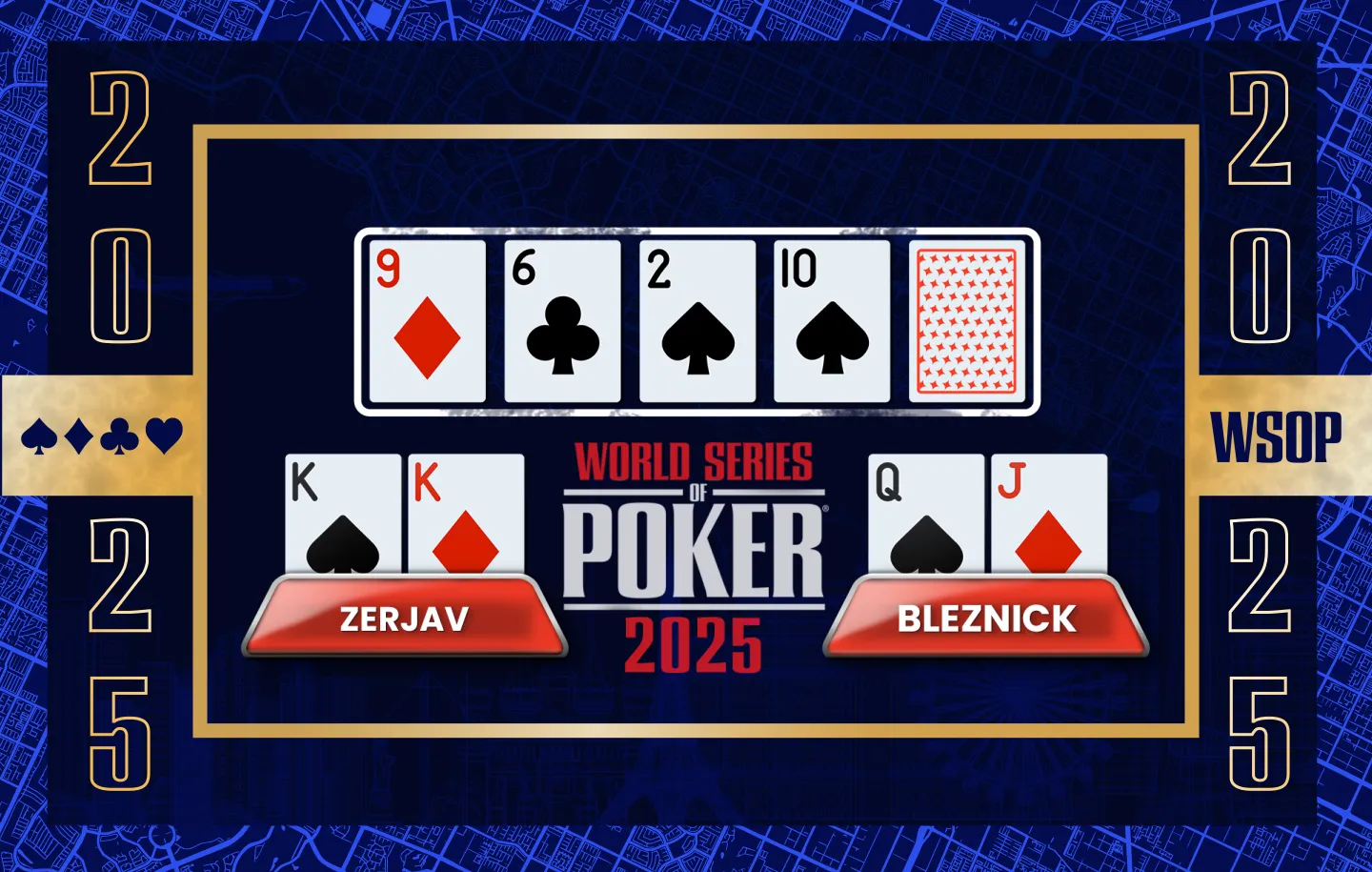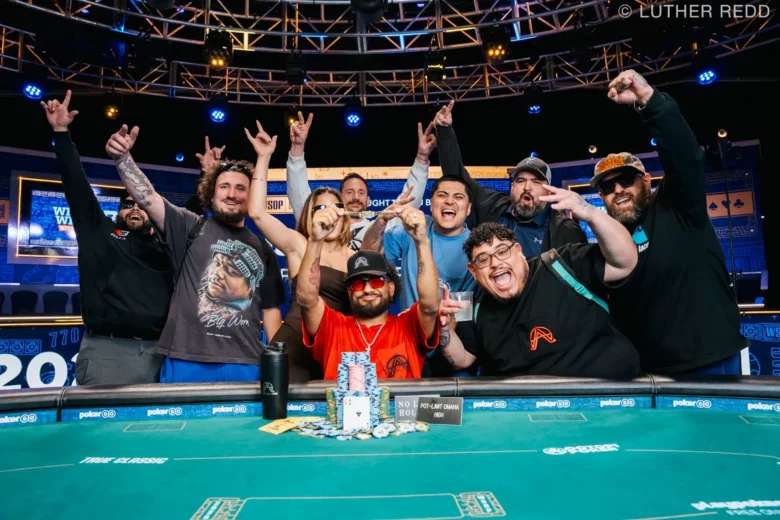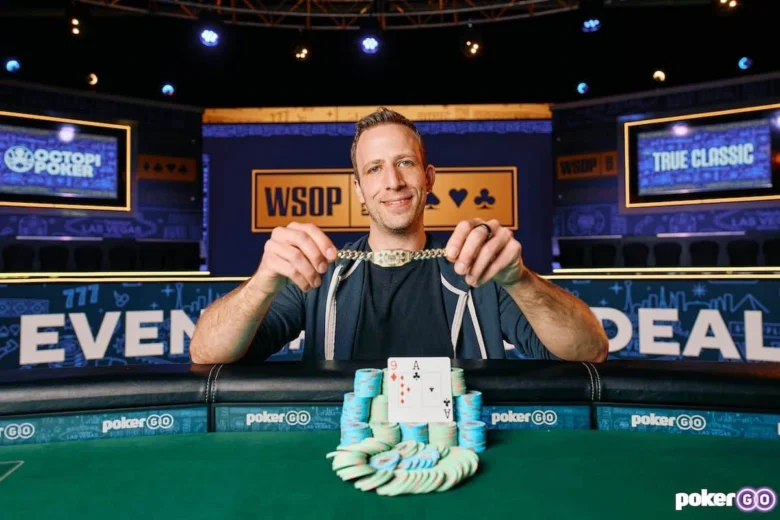Breaking Down the Biggest 2025 WSOP Hands – Part 2

-
T&Cs Apply | Play Responsibly | GambleAware
18+ | Play Responsibly | T&C Apply
-
T&Cs Apply | Play Responsibly | GambleAware
T&Cs Apply | Play Responsibly | GambleAware

- Fact Checked by: PokerListings
- Last updated on: November 9, 2025 · 10 minutes to read
The 2025 World Series of Poker continues to shine as poker’s biggest names are making waves at the annual event! Let’s recap some of the more memorable hands that have taken place over the last week and a bit!
Event #14 – $25,000 High Roller NLH / PLO – Garza Comes Back from 2 Big Blinds
At one point in the tournament, Lou Garza was down to just 2 big blinds and on total life support. Later, he faced a 4 to 1 chip disadvantage, but he overcame both to end up in the winner’s circle. We found this hand that seemed to start to really turn the tide towards Garza’s favor to winning his second bracelet.
From the button in level 29, Garza raised the big blind from 300k to 750k, getting a call from Lamb in the big blind. On the flop, both checked to see an ace pop up on the turn, to which Garza put out a 1.1 million bet, to which Lamb called.
The river appeared to be a brick – the 5 , and Garza fired again, sending 3.7 million into a 4 million pot. This took Lamb into the tank before he found a call – and subsequentially mucked the losing hand, pushing Garza up to 14.5 million versus Lamb’s 22 million stack.

Heads-up poker can be the toughest game to master simply because most poker players don’t have a lot of real game experience playing heads-up – the only times one will encounter this is when you get to that point in a tournament – and even the best poker players in the world don’t often get to heads-up, and if you are playing in a heads-up tournament.
Most of these will not be of the $10k buy-in for a WSOP bracelet, but these are factors as to why Ben called off this bet at the end.
Anytime you get blind on blind action, and the small blind raises, you are going to see the big blind call – it’s almost a guarantee, so Ben calling here should surprise no one. The check on the flop is interesting from Garza – Ben may have missed an opportunity to taking control on the flop with a bet into the 1.8 million pot.
The best poker players in the world know how to extract as much value out of a hand as possible, and Ben most likely checked out of position, knowing that Garza would bet at some point.
Betting on the flop out of position can be very awkward when you get called and you don’t improve on the turn, as would have been the case here. By being passive, Garza dictated how much Lamb needed to pay to see the river, where Lamb could have had a line to bet the flop, or raise the turn and get the same info for less than the 4.8 million he ended up paying in the end.
He clearly did not have Garza on the ace – he’d never call the river if he did – but by being passive up until that point, he had no way to validate if that turn card helped Garza or not, and as such had to call off with second pair.
Having said all of that, Lamb did well to minimize the damage as if he would have raised on any street, hit’s not likely he would have gotten a fold from Garza given his hand which was unfortunate for Lamb that Garza was in the top part of his range. And while Garza was down to 2 big blinds at one point, this swing of momentum certainly helped Garza take Lamb out shortly after to win WSOP Bracelet #2.
Photo Credit: Luther Redd
Event #15 – $1,500 Mixed PLO H/L 8 or Better – Glaser Goes Back-To-Back
Benny Glaser might just be the greatest mixed games player in WSOP history after his second bracelet in non-Hold’em events was won in event #15 earlier in this year’s series.
The win gives Benny 7 bracelets lifetime but all have come in mixed games, and he is among only 11 other players who have 7 WSOP bracelets to their resume. This win was an epic battle between Glaser and Travis Pearson, and one hand that swung to Glaser is what we’ll dive into now.

In level 36 with blinds at 300k and 600k playing PLO H/L, with Pearson holding the chip lead, Glaser raised pre-flop to 700k and Pearson called. On the flop, Pearson donked 800k and Glaser decided to come along to the turn.
Pearson slowed down and opened the door for Glaser to re-take control, betting 2.2 million to which Pearson felt compelled to see a river. That river brought a check from Pearson, and all-in from Glaser. After a few moments, Pearson went for the win, but got denied as Glaser scooped the pot.
We mentioned in the last hand that heads-up poker essentially is no-fold pre-flop territory for almost any hand, so seeing Glaser triple-suited and raising isn’t a shock to anyone. The interesting part of this hand was the flop aggression Pearson showed with his gut-shot straight draw and second pair, and then slowing down on the turn and river when he hits his straight. His attempt to draw all of the chips in worked, but the poker gods decided that this battle was just getting going and the trap backfired on him.
To Glaser’s credit, calling the donk bet with so many outs on that flop must have felt like a potential dream sequence was setting up. His third pair + open-ended straight draw gave Benny so much equity that when the Ten hit the flop, he might have felt like he was ahead with the two pair + Pearson’s aggression now becoming passive – especially when Pearson checked the river.
With Glaser’s stack, he may have gone for it regardless of what the river card actually was and he could have been eliminated, but just like in online poker, the river can bring awful beats to players and Pearson must have felt like he was punched in the gut when that Five made Glaser the full house.
I would have like Pearson to have check-raised on the turn to put the pressure on Glaser to call behind – winning a small pot is better than losing a massive one but the edges that poker players must take at the top level will always open the possibility of allowing your opponent to get there in the end. Given the stakes involved, the donk on the flop, followed by the check-calls on turn and river is an interesting line.
Photo Credit: PokerGO
Event #18 – $10,000 Dealer’s Choice – Chip Leading Every Day For The Win
Ryan Hoenig was the tournament chip leader on every day of the $10,000 Dealer’s Choice Championship, running away with the title and capturing his first WSOP Bracelet and a $354k payday.
Hoenig took out both Philip Sternheimer and Dylan Smith at the final table, and we’re going to break down an interesting hand where Hoenig eliminated Sternheimer.

On level 25 playing Pot Limit Omaha, with blinds at 50k and 100k, Hoenig was on the button and raised to 100k, to which Sternheimer called from the big blind. On the flop, Hoenig lead out for 75k, to which Sternheimer called to see the turn where Hoenig upped the aggression to a 350k bet, to which Sternheimer again called.
The river brought a shove from Hoenig, to which put Sternheimer’s 1.1 million chips left at risk and sent him deep into the tank. Some table banter occurred, eventually leading Sternheimer to call off and see the bad news, eliminating him in 3rd place.
It seems to be a theme in these hand review series that if you have read several, you would have picked up those players – amateurs and pros alike – who take more of a passive line post flop tend to get themselves into trouble on the river and face calls for the majority of their chips – or all of their chips in this case – where they do not have a solid idea of where their hand is relative to their opponents.
In this hand, Sternheimer clearly was agitated with how this went as he asked Hoenig if he would show if he folded. Hoenig said no, and then Sternheimer verbally exposed his hand, claiming that he had a straight and blockers to a full house, but without a response from Hoenig, Sternheimer ended up concluding that his hand was strong enough to call.
His read was correct that Hoenig didn’t have a full house, but he did not block the nut straight – which Hoenig had. We’ll never know if Philip took that into account in his analysis but ultimately had to dwell on that call as he walked to the rail in 3rd place, and looked on as Hoenig took the bracelet.
Event #22 – $25,000 High Roller – Zerjav Pulls Off The Epic Comeback
Blaz Zerjav, the online poker star took down his first WSOP bracelet, and in the process denying Chris Moorman his third bracelet by coming back to win the $25,000 High Roller, beating 335 others to win $1,7 million for his career biggest win.
Starting heads-up, Zerjav faced an almost 4 to 1 chip disadvantage, but we’re going to rewind back to 4 handed with Landon Tice and Jared Bleznick still in play to a key hand that happened with the eventual champion.

At level 23 with blinds at 120k and 240k, Moorman raised up to 480k and Bleznick three-bet to 1.5 million. Zerjav wakes up with kings and meant to say 3.3 million, but said 1.3 million instead, and was bound to a call by the dealer, and Moorman bowed out.
On the flop, Bleznick fired 1.2 million, which brought a smooth call by Zerjav. Bleznick pumped the brakes on the Ten of Spades turn, which brought a 1.5 million bet by Zerjav – not enough to deter Bleznick to fold. The river brought another spade – the 3 – and a shove by Zerjav which got Bleznick to lay down the inferior hand, and sliding an almost 6 million chip pot to the online star.
Normally when a player mis-clicks like Zerjav did brings a lot of questions to the players at the table, and Bleznick either didn’t pick up on the mistake and view it as a red flag, or Bleznick was strong to smooth call a four-bet and then continue to bet on the flop and turn. Given that, Bleznick’s three-bet call with Queen-Jack against two potential players in the hand is interesting to say the least as he didn’t know Moorman was going to fold.
Bleznick’s aggressive line on the flop was intriguing given the missed four-bet from Zerjav, and when he got called, the alarms should have gone off in his head, especially when the turn brings another paint, completing a broadway draw and giving another card that Zerjav could have hit a set with.
The river bricks the flush draw, and the paired river may have pushed Bleznick to folding versus calling. It’s hard to think that he would have been ahead on the turn given the board and pre-flop – what card was Bleznick looking for to improve – a jack? So, he’d have two outs which makes that call strange. Regardless, the right decision was made on the river but it didn’t help Bleznick at the end.
This year’s series has been one of the most enjoyable and engaging to watch thus far, and the best is still to come with many more big tournaments on the horizon, producing even more great moments! We can’t wait to see what is going to happen next!
Photo Credit: Austin Corrington
Read more:
- Biggest 2025 WSOP Hands – Part 1
- Biggest 2025 WSOP Hands – Part 2
- Biggest 2025 WSOP Hands – Part 3
- Biggest 2025 WSOP Hands – Part 4
- Biggest 2025 WSOP Hands – Part 5
- Biggest 2025 WSOP Hands – Part 6
- Biggest 2025 WSOP Hands – Part 7
- Biggest 2025 WSOP Hands – Part 8
- Biggest 2025 WSOP Hands – Part 9
- Biggest 2025 WSOP Hands – Part 10
- Biggest 2025 WSOP Hands – Part 11
-
Stake.US Poker4.3
- Rakeback 5%
- $55 Stake Cash + 260K Gold Coins
T&Cs Apply | Play Responsibly | GambleAware
18+ | Play Responsibly | T&C Apply
-
Appeak Poker4.1
- 1,000 Chips Daily
- FREE 5,000 Chips
T&Cs Apply | Play Responsibly | GambleAware
T&Cs Apply | Play Responsibly | GambleAware
-
- 2,500 Gold Coins + 0.50 Sweeps Coins
T&Cs Apply | Play Responsibly | GambleAware
18+ | Play Responsibly | T&C Apply
-
WSOP.com4.3
- Up to 70%
- 100% up to $1000
T&Cs Apply | Play Responsibly | GambleAware
T&Cs Apply | Play Responsibly | GambleAware
-
CoinPoker4.1
- 33% Weekly
- 150% up to 2000$
T&Cs Apply | Play Responsibly | GambleAware
+18 / T & C apply / Play responsible
